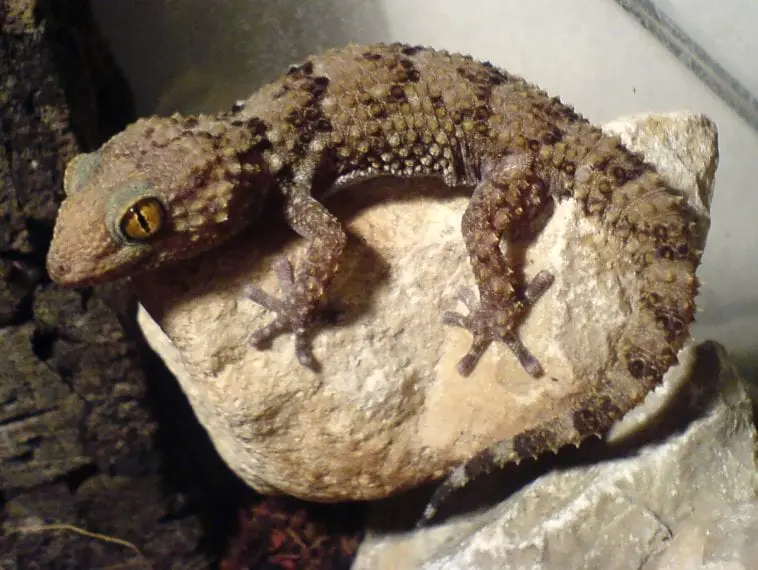Scientific Facts
| Common Name | Bibron’s Gecko |
| Scientific Name | Pachydactylus bibroni |
| Life Span | 5 to 8 years in captivity |
| Size | Adults can grow 4 to 6 inches in length |
| Habitat | Arid environments with rocky outcroppings and crevices |
| Country of Origin | Southern Africa |
Physical Description

Bibron’s gecko is a species of gecko that is endemic to southern Africa, where they spend their days hiding inside the ideal hiding spot. This gecko can be seen in between rocks and tree barks and are more active during nighttime than in the morning.
The name Bibron’s gecko was in honor of French herpetologist Gabriel Bibron, and aside from its name, other names for this gecko are Bibron’s thick toed gecko and Bibron’s sand gecko.
An adult Bibron’s gecko can measure from 15 to 20 cm with a medium to large build. The large, broadhead is common to the family Gekkonidae, including its brown-grey eyes with vertical slits with lacking eyelids.
The Bibron’s gecko has interesting designs with brown background dorsal color. Also, olive-gray, black, and white tubercle scales covering the head, creating a very rough appearance.
The Bibron’s gecko is a silent species of gecko. Many first-time reptile and lizard owners prefer this gecko species compared to others because of its size, easy and docile nature, and ease of care.
Life Span

A Bibron’s gecko can live up to 8 years in captivity. There is no known record of how old this lizard can live in the wild. Experts believe that captive breeding can improve the chance of survival of this lizard.
The Bibron’s Gecko has three life stages, just like most lizard species:
Hatchlings
After the gestation period, hatchlings will come out of their eggs; each baby will be ready to eat size-appropriate food. Each hatchling is already able to walk and crawl, and therefore, you should secure the tank cover at all times.
Juvenile
During the juvenile stage, the male and female geckos are fully equipped and skilled in hunting for food. The male and female will have the same weight and size. The lovely prints on adult gecko skin may already be present in juvenile geckos.
Adult
Adult Bibron’s Geckos reach maturity in just a few months. The males will grow larger and heavier than females. When breeding in captivity, these geckos can take time to adjust to their environment, but usually, these are ready to reproduce once they turn into adults.
Eating Habits
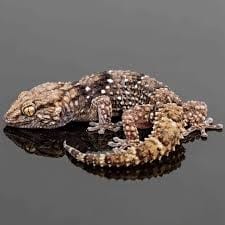
This gecko is insectivorous in the wild; therefore, you must follow its diet in captivity. Serve live food like mealworms, crickets, waxworms, silkworms, and pinkie mice. Baby geckos should be given live crickets daily. Juvenile and adult geckos may be fed with nine crickets or mealworms in a week.
Expert lizard handlers recommend feeding ½ sized crickets that are hatchlings and 2/3 sized crickets for a juvenile to adult geckos. Place the crickets inside the cage or enclosure so these can move around the area. If your pet does not eat the cricket after a few hours, remove the prey inside the pen.
Since this gecko is nocturnal, feed it during nighttime. Don’t leave its prey inside the tank in the morning. Just place it in when the gecko is awake.
Water
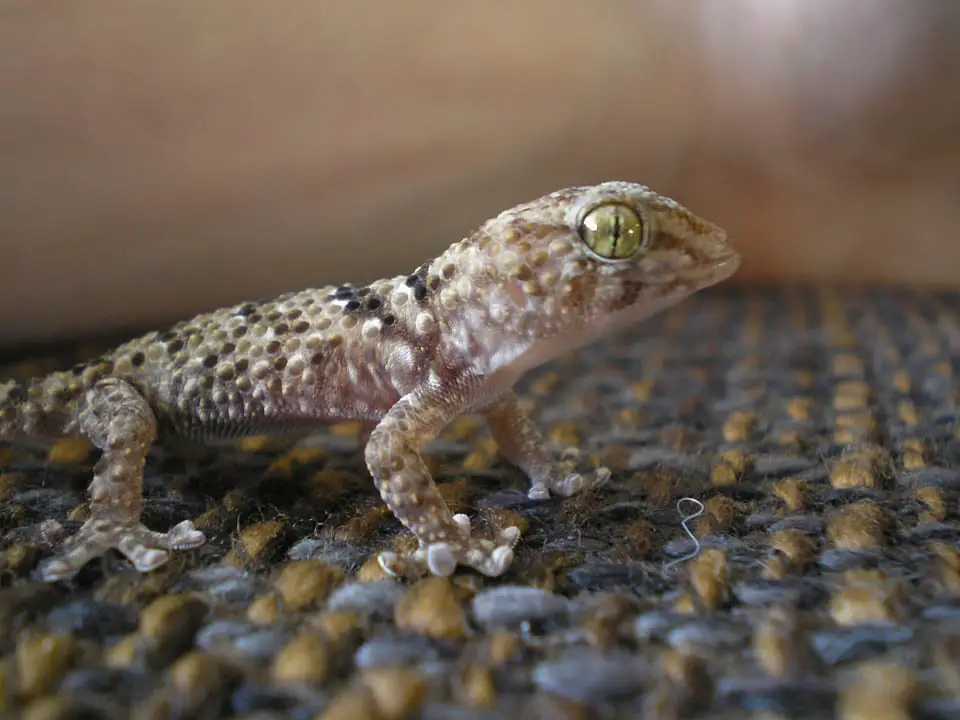
Bibron’s Geckos require fresh water. Let a dish of clean water remain inside its enclosure. Change this water daily and clean the dish regularly too to prevent bacterial contamination inside the enclosure.
Development and Reproduction
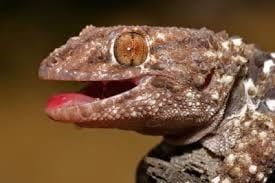
Bibron’s geckos mate during the breeding season, which happens in just a few months in a year. The male and female gecko takes advantage of the short breeding time to mate frequently to increase the chance of increasing their family.
After mating, the female will lay around two clutches in a year with two eggs in a clutch. The baby Bibron’s gecko needs a long 18 months to come out of their shells. The hatchlings are around 2 inches long, and the patterns are very distinct.
How to Breed
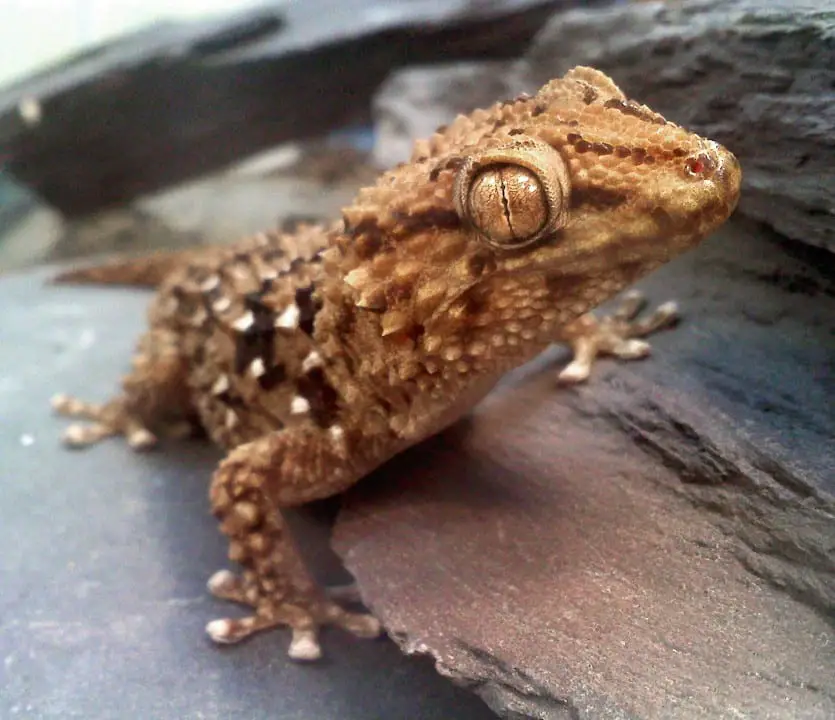
Breeding Bibron’s geckos are easy to breed. The first thing is to consider the breeding environment of your geckos. The temperature and humidity levels must be maintained to nurture mating geckos. And once the male and female have mated, remove the males.
The female gecko will deposit her eggs in a place inside the tank that’s safe and warm. Once the eggs have been deposited, remove them and place in individual cups filled with substrate and place these cups under bright light.
After a few weeks, the eggs will crack open and outcome hatchlings. These baby geckos are ready to move out of their eggs after a few days, and by this time, these are ready to eat and hunt.
Common Health Problems
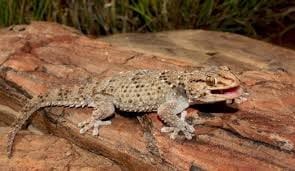
Here are the common problems that Bibron’s Geckos may encounter:
Metabolic Bone Disease
Geckos require calcium for strong bones and vitamin D3 to use up calcium. You can use calcium supplements to feed your lizards while geckos can get D3 by basking under UVB lamps in your tank.
MBD is due to poor calcium levels in bones, and symptoms range from deformities in the lizard’s skeletal system to bowed legs and a rubbery jaw that affects the way they eat their food.
MBD is reversible by increasing vitamin D3 and calcium intake. Calcium supplements may be given by dipping your finger in calcium powder and wiping this in your gecko’s mouth. You must invest in a reliable UVB lamp for efficient vitamin D3 intake.
Parasites
Geckos come with a low level of parasites, which won’t affect their health, but if it becomes stressed or suffer from immune system conditions, the parasites can multiply and affect their health.
These microorganisms can multiply and affect animals and humans. And to avoid the spread of parasites and infections, you must quarantine a new gecko pet. Check for signs of parasitic infections such as smelly or runny waste, weight loss, a large abdomen, low appetite, and lack of energy. If you notice any symptoms of parasites, take your pet to the vet. Always clean and disinfect your pet’s enclosure to avoid reinfection.
Stress
Geckos can be prone to stress, and stress may be due to many reasons like a new environment, overcrowding, poor cage maintenance, and breeding. Usually, geckos that are stressed may not eat and may have depressed immune systems. Stress can also lead to problems shedding. And usually, too much handling can also stress a pet gecko.
Poor shedding
Healthy geckos that live in an enclosure with good living environments will shed regularly. Take note of signs of shedding difficulties like shedding in pieces, skin clinging on the tail or the eyes, and restlessness could mean poor shedding.
Stuck skin must be removed right away because this can cling on the leg or tail and can cause constriction. Soaking in warm water for a few minutes can help remove stuck skin.
But for severe shedding conditions, consult a vet at once. A vet will remove incomplete shedding and will treat wounds or cuts if these are present
Preventing Illness
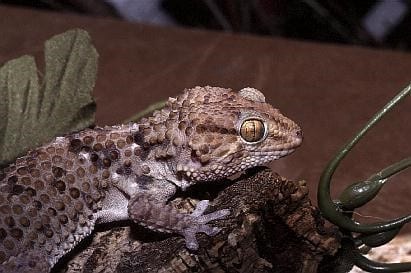
Keep the gecko tank temperature and humidity in the ideal consistent levels. Let a bowl of water remain inside the tank to improve humidity. Your gecko may also drink water from this bowl.
Keep the tank clean. A dirty, unkempt tank can lead to bacteria growth inside the enclosure and can affect your gecko’s health. Clean the tank using an effective cleaning product and never anything that can leave residue and toxins.
Feed your gecko the best food and consider organic pet food. Never feed insects and worms captured from the wild because these may contain toxins coming from pesticides, which can affect your gecko’s health.
As much as possible, quarantine new lizards. New pets can pass on mites and illness to your other pets, so you must be certain about your lizard’s health before you introduce it to the main tank where your other lizards are. Allow a week or two for the new gecko to remain in quarantine to rule out any kind of pest or disease
Behavior
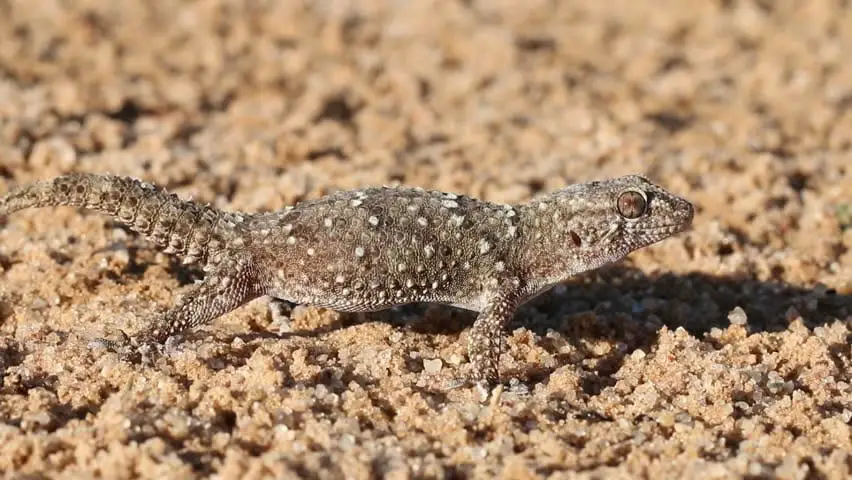
To better understand your pet Bibron’s Gecko, here are some of its behaviors
Nocturnal creatures
A lot of reptiles are nocturnal, and this gecko is one of them. It will happily explore, feed, and hunt during the evening and will remain quiet and still during the mornings. With these in mind, feeding has to be done in the evening, and prey must not be left loose inside the tank when the gecko is asleep.
Prefers living prey
Although not all Bibron’s gecko will eat dead prey, some breeders have noticed this odd behavior. So if you are doubtful as to whether your gecko prefers its food dead or alive, monitor its behavior during meal times.
Gender depends on the temperature
The gender of a clutch of eggs may depend on where the eggs were deposited. Eggs that are deposited in an area with cooler temperatures have more males in it. Meanwhile, eggs that are deposited in warmer areas may have more female members.
They may bite
Yes, this gecko may bite, and according to breeders, you must be careful when this happens. Biting is used to secure dominance while some geckos bite to show that they are stressed.
Very territorial
You must never keep males together because these may fight and cause severe damage. Bibron’s geckos are very territorial and may not do well if it has another companion inside its cage.
Shedding
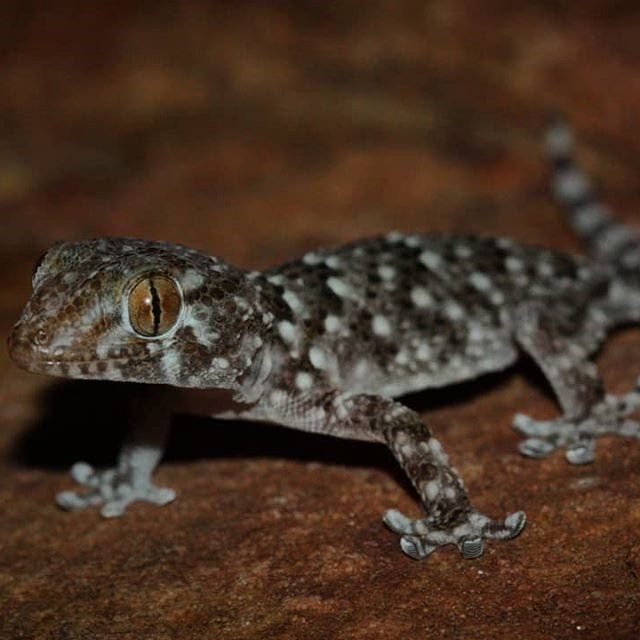
Shedding should be complete in healthy geckos, but some may suffer from incomplete shedding where the parts of the tail, hands, feet, and eyes may not shed properly. Instead of shedding in one piece, flakes of skin fall off, and to make things worse, dead skin can constrict a body part, and this can injure your pet a lot.
To counter incomplete shedding, improve humidity levels inside the tank. Soak your gecko in warm water for at least a few minutes to loosen dead skin. In geckos like the Bibron’s Gecko, shedding happens regularly in juveniles lizards and can happen less frequently in adults. Shedding is stressful to so it’s best to leave it be when it’s shedding and to interfere only when your lizard has incomplete shedding.
Habitat
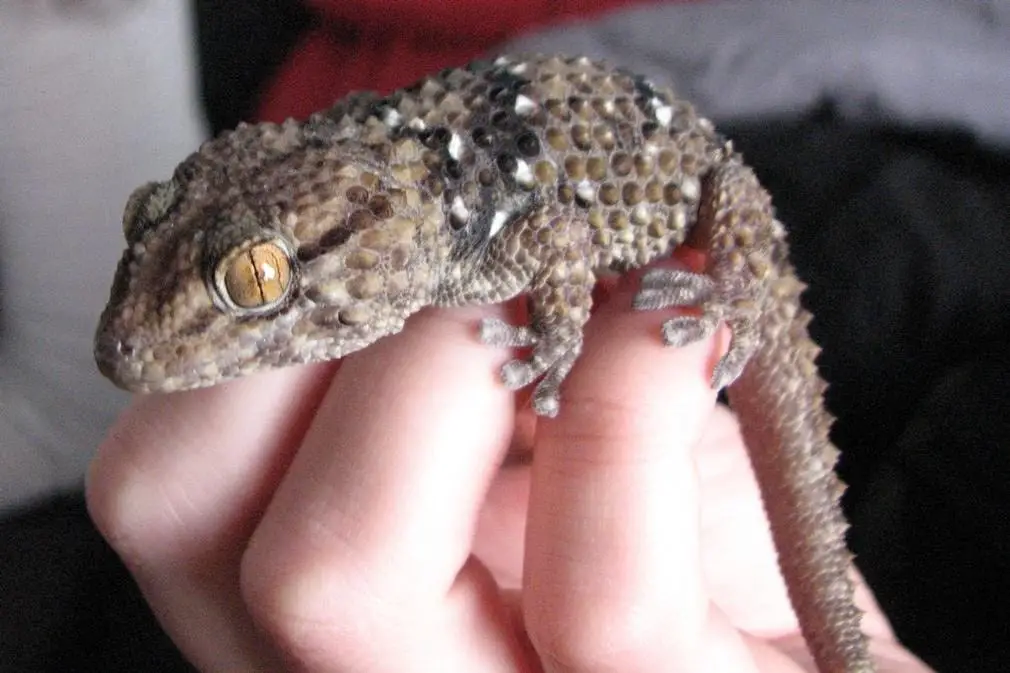
For a lizard as big as a Bibron’s Gecko, a larger 20-gallon tank is a good idea. One or two geckos can stay in one tank, but during breeding time, place one male is to two or more females in one tank for better success inbreeding.
A tank should be large enough to have room for gecko accessories like food dishes and water dishes. Include rocks, branches, and places where your pet can sit, bask, and enjoy the warmth of the light. Cover the top with a screen to prevent pets or predators from entering the tank and preying on your pet gecko.
The tank must be placed in a quiet environment like a spare room, basement, or attic so that this lizard can recuperate during the day. This is a nocturnal creature and will be energetic in the evening when everyone else is asleep.
Lighting, Humidity, and Temperature
Provide an efficient lighting system for your gecko. More pet owners use incandescent lamps and follow a 12-hour lighting schedule to mimic natural daylight.
Incandescent lighting is also a source of heat. The tank should also remain on top of an under-cage heating pad. This heating tool will keep the tank in comfortable temperatures of 75 to 90 degrees Fahrenheit in the morning and 85 to 90 degrees Fahrenheit in the evenings.
Whatever happens, maintain good humidity levels inside the tank. Use a mister with water and spray inside the tank to maintain humidity. Also, a bowl of water can maintain tank humidity. Meanwhile, a more accurate way to keep the tank in good humidity levels is a humidifier. This is an electronic device that can correct the humidity of the tank.
Tank Bedding and Accessories
Bibron’s Geckos are nocturnal, so your tank has to have accessories where your gecko can sleep soundly in the mornings. You can use an elaborate piece of accessory or something simple, but remember your pet’s safety is most important. Also, accessories inside the tank should be safe, and without any pointed edges that can hurt your gecko.
Sometimes the simplest accessories will suffice like an overturned pot or an old shoebox. Place this hide near the heat source as much as possible but place another one far from the light source.
For the bedding, use paper substrate so you can easily clean it and remove it. Use newspaper, butcher, paper towels, or packing paper or paper towel. Never use sand because the gecko can ingest this as he picks up his food. Do not use substrate materials with too much smell, which can affect the health of geckos.
Sanitation
Clean and maintain your gecko’s cage with safe cleaners. You can use a simple solution made up of bleach, dishwashing soap, and water. But make sure to rinse everything before you place the gecko inside. You may also use baking soda to clean the tank and remove foul odors.
If you want to use chemical cleaners, follow the instructions on the cover completely, and always wear protective equipment like gloves, masks, and goggles. Never use two cleaning agents at a time and always rinse the tank and all accessories with running water. Dry the tank using paper towels before placing all the accessories and your pet. You may also use boiling water to remove harmful pathogens inside the tank and clean all the tank accessories as well.
Availability – Where to Get One?
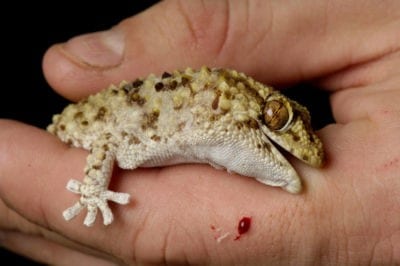
You can purchase a Bibron’s Gecko from a local pet store or reptile trade shop for less than $20. The price varies depending on gender, size, and coloration. If you want to buy online, you need to spare time for deliveries and shipment, and the cost can dramatically increase.
How to Care for a Bibron’s Gecko
Your Bibron’s Gecko’s care outcome in the following tips.
- Always keep the tank in good humidity. This will prevent many illnesses, encourage complete shedding, and keep your gecko healthy.
- This gecko is a nocturnal creature, so it will hunt in the evenings and sleep in the morning. Place the tank in a quiet area like a spare room, attic, or basement.
- Handle your gecko early on so it will develop trust in you as its owner and handler.
- Frequent handling also reduces stress but learn how to do it correctly.
- Avoid overcrowding. Use smaller tanks for breeding and laying eggs.
- Change your substrate regularly to prevent mold, bacteria, and parasite growth inside the tank. Never reuse substrates because this can lead to terrible health conditions.
- Change the water inside the bowl, and don’t let this empty because this improves humidity inside the tank.
- Feed your Bibron’s Gecko the best kind of food. Use organic insects to avoid pesticides and chemicals that can harm your gecko.
- Take your pet to the vet for regular checkups and any medical emergency. For cuts, abrasions, abscesses, and wounds, consult a vet as soon as possible
FAQs
What do Bibron’s geckos eat?
Bibron’s geckos will eat insects and a few leafy greens. Some owners use mice, which is the best way to deliver nutrients to your pets. Gut loading is placing nutrients or supplements inside prey, and this is fed to the lizard as a regular meal.
How much food does a Bibron’s gecko eat?
It may depend on the size of the gecko and also according to its nutritional requirements. If the gecko is still young (hatchling or a juvenile), it may require frequent feedings, while egg-laying geckos may need to be fed more as well.
Will Bibron’s geckos eat their young?
There is no record or report that a breeder has witnessed this, although some gecko species eat their own young. It is also not known as to why this happens, but some say that it may be due to a fight for dominance.
Is this gecko dangerous?
No, Bibron’s geckos are not dangerous and will rarely bite you. It is known to be one of the easiest to care for and will exhibit a docile attitude as long as you handle it early. New lizard owners should learn how to hold their pets early.
How do you breed this gecko?
This gecko may be bred in captivity, and it starts with choosing a healthy male and female. Breeding happens quickly, and once the female is pregnant and ready to lay eggs, she will look for a good spot to do so.
A Bibron’s gecko territorial?
Yes, Bibron’s geckos are very territorial, and sometimes, these can fight till one bleeds or dies for territory. If you have several males, house each one in separate tanks or enclosures to prevent fighting.
Can you get Salmonella from handling a gecko?
Some geckos come with parasites, which may not affect them at all. However, this is very dangerous to humans and other pets. Salmonella is just one of these dangerous illnesses which can be transferred from a reptile to a human with symptoms of vomiting, diarrhea, severe abdominal pains, and so on.
Where can you buy a Bibron’s gecko?
Check a local pet store or exotic reptile store near you. Or you may look for good specimens from online pet stores. You may also adopt a gecko from a friend or from the pound, which is a good way to end indiscriminate buying and trade of lizards.
How do you train a gecko to follow you?
Some breeders say that a Bibron’s gecko can understand their owners and may even recognize their owner’s voice and smell. Constant handling and careful hands will allow you to train your pet to respond to your calls and signs.
Is a Bibron’s gecko endangered?
No, it is not an endangered species and is not part of an endangered species list. But extra care is recommended when buying this from a dealer.

